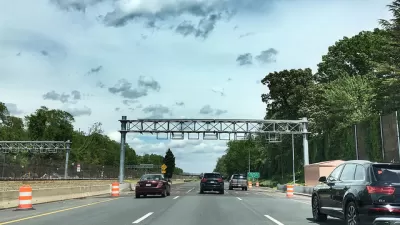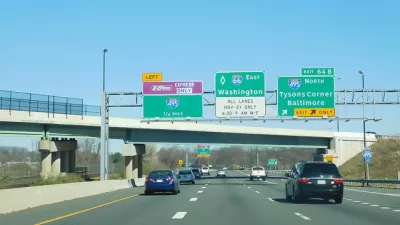The peak tolls achieved during the first week of operation of the new HOT lanes on I-66 in Virginia raised eyebrows this week. Here's a closer look at the data behind the new system.
Mike Grinnell takes a deep dive into the data behind the I-66 express lane system that went into operation this week, making headlines for charging $40 to access the new HOT lanes during the Tuesday morning peak period.
First, Grinnell makes clear the changes this week on I-66:
A few things changed for drivers with the introduction of these new HOT lanes, but the biggest change was for single-occupancy vehicle drivers. Previously they were restricted from driving on I-66 eastbound between 6:30 am and 9:00 am and westbound between 4:00 pm and 6:30 pm. Outside of these time restrictions, they were free to access the roads anytime.
Then, Grinnell compares the actual toll prices to the estimates prepared by the Virginia Department of Transportation two years ago when planning the HOT lane system. Despite the eye-popping figures picked up by news outlets around the country (including us), the numbers did hold pretty close to the original estimates.
By taking a closer look at the numbers, Grinnell is also able to pull a couple early lessons from the system, including when driving is most expensive and insight into how dynamic pricing works. Grinnell also reminds readers that the tolls will pay for the installation and upkeep of the tolling system in addition to multi-modal transportation improvements like bus service, park-n-ride facilities, improvements to Metro, and road improvements.
FULL STORY: After the outcry over the $40 tolls on I-66, this solo driver crunched the numbers

Alabama: Trump Terminates Settlements for Black Communities Harmed By Raw Sewage
Trump deemed the landmark civil rights agreement “illegal DEI and environmental justice policy.”

Planetizen Federal Action Tracker
A weekly monitor of how Trump’s orders and actions are impacting planners and planning in America.

How Atlanta Built 7,000 Housing Units in 3 Years
The city’s comprehensive, neighborhood-focused housing strategy focuses on identifying properties and land that can be repurposed for housing and encouraging development in underserved neighborhoods.

In Both Crashes and Crime, Public Transportation is Far Safer than Driving
Contrary to popular assumptions, public transportation has far lower crash and crime rates than automobile travel. For safer communities, improve and encourage transit travel.

Report: Zoning Reforms Should Complement Nashville’s Ambitious Transit Plan
Without reform, restrictive zoning codes will limit the impact of the city’s planned transit expansion and could exclude some of the residents who depend on transit the most.

Judge Orders Release of Frozen IRA, IIJA Funding
The decision is a victory for environmental groups who charged that freezing funds for critical infrastructure and disaster response programs caused “real and irreparable harm” to communities.
Urban Design for Planners 1: Software Tools
This six-course series explores essential urban design concepts using open source software and equips planners with the tools they need to participate fully in the urban design process.
Planning for Universal Design
Learn the tools for implementing Universal Design in planning regulations.
Jessamine County Fiscal Court
Caltrans
Institute for Housing and Urban Development Studies (IHS)
City of Grandview
Harvard GSD Executive Education
Toledo-Lucas County Plan Commissions
Salt Lake City
NYU Wagner Graduate School of Public Service




























